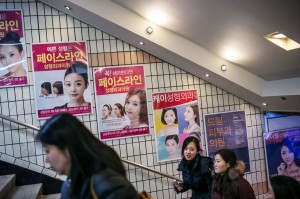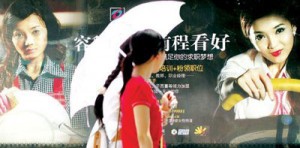

right: Photograph by Jean Chung, March 23, 2015. http://www.newyorker.com/magazine/2015/03/23/about-face
left: July 20, 2007. http://www.china.org.cn/english/education/217877.htm
After these past two weeks of class, I have learned so much more about the desired beauty for Asian women in the modern world. My partner and I read the article, “Nennu and Shunu: Gender, Body Politics, and the Beauty Economy in China” by J Yang. This article focused on the concept on Nennu and Shunu. These two words are directly translated as, “tender” and “ripe,” and women are desperate to be characterized in this way.
Overview of Photos: The photos above, show two pieces of plastic surgery advertisements scattered around Asia. The one to the right, is a metro station in Seoul, South Korea, while the other is displayed in China. Both showcase and are trying to promote plastic surgeries to whomever walks by.
Focus of Photos: To the left, we see the Chinese women staring at the advertisement. The pair have completely passed by the unattractive before photo, and have settled their gazes on the newly done women looking back at them. The ad shows a huge transformation being done on this woman, not only relating to her face. After undergoing the surgery she completely changed her lifestyle. The first picture of her makes her look like a sad worker who is struggling to make it by, but in time she changed her appearance, and now she is out of work and driving her new car. Her face has been completely redone, including makeup as well as new features. The pedestrians seem mesmerized by this drastic change. That is one way in which advertisements are gaining the attention they need. Women who see this believe this could be them as well. The ad displayed above is very well done. The drastic changes between the two photos make what they are selling much more desirable.
The image on the right, has been taken in Seoul and shows a scene inside a metro station. The ads are continuously plastered along the wall, desperately looking for someones attention. However, the women leaving the station are not laying an eye on them. The ads brighten the drab stairwell, by adding color and excitement and showcasing the different surgeries one can undergo to become a newer woman. These ads go well with the concept J Yang mentions in her article. Nennu and Shunu is represented here in the everyday life of Asian women. The women in the ads are new, but still have the ripeness (shunu) they also desire to have. But the main desire for older women is to appear as tender (nennu) and are undergoing surgeries to do so.
Conclusion: I believe these two photos do a great job explaining what my article, “Nennu and Shunu: Gender, Body Politics, and the Beauty Economy in China,” was trying to convey. It mentioned the ads and the transformations Asian women are seeking desperately. The perfect medium of Nennu and Shunu is very much desired by all women in the modern world, that this article even correlated with plastic surgeries in the Western World. An example of this is the amount of celebrities in the West who have undergone plastic surgeries to keep the young looks they once had. After reading this article, it could easily be connected to things I know about America and the modern world we live in.
very nice description of the two ads. you could turn the description into analysis if led by the questions of how the ads convey the messages of transforming woman from a shunu to nennu.
